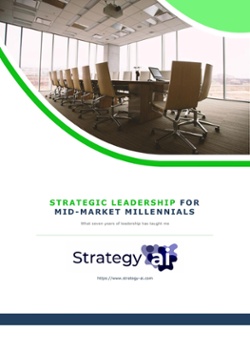In the fourth part of this series of articles I took a deep dive into some of the details of the changes we made, how we manually implemented those changes as well as the challenges we faced with the systems and tools available. This final article provides details on how Strategy-AI addresses those issues while moving your better, modern leadership to an automated digital leadership. This whole series is also available as a download.
From manual, Excel overload to truly automated strategic leadership
I had ownership of the workshop I had built around this review process and I was making every effort to make it more repeatable, capable of higher a frequency, something our managers and team leads could use, but the lack of tooling made the overheads a challenge. It irked me that the people we relied on, to actually implement the vision and direction set out by the leadership team, didn't have the tools they needed. I had a kludge of a solution with Excel and exporting data, but this wasn't practical to fit into the slick world of agile tooling the business was using. It was okay as a disconnected retrospective, clumsy and manual... but to me, it fell short of what it should be... proactive and not reactive. I wanted something that would fit seamlessly into the tooling we were already using without data exports. I just couldn't find anything. It came to a head when I decided that if I wanted this tool, I'd have to build it myself. Luckily my background is as a software engineer and architect.
This was why I left consulting and management and started Strategy-AI. I wanted to build that vision of a properly digital, proactive and fully immersive tool, from the seed of that Excel spreadsheet we had used in our retrospectives. One that could still be used as a tool for a review or audit after the fact... but far more importantly, a tool that could be used by managers and team leads (the one we, as leaders, rely on to implement our vision) when those sub-projects, tasks and sub-tasks were first created, so that the unnecessary, unintended work could be spotted as early as possible. Because it wasn't us, and it isn't you... It's that one little missing piece. It's that skill we've got experience at, but don't use as often as we should, because we don't have the tool to make it practical to implement... or at-least that was the case... until I built it in the form of Strategy-AI.
Strategy fully integrated with business
Strategy-AI went live earlier this year, with everything I could cram into the time and budget I had to focus on it. It's kept to its core vision: fully embedded and immersive, right where it's needed and as scarily simple as possible. It's targeted at the group leaders rely on most, for those 51 weeks of the year and the ones that have the fewest tools to help them out; the managers and team leads.
Where the workshop and Excel had the overhead of prep work, Strategy-AI has none. Where the workshop struggled to give us a proactive ability to stop wasted work being done at the earliest possible moment, Strategy-AI lets you proactively catch things at the moment it's thought of. Where the workshop required a few hours to go over several months of work items, Strategy-AI now presents rolling reports on demand.
The moment a sub-project, task or sub-task becomes a thought and is captured you can assess it. A quick check-point. When your team is brain storming the sub-projects of a bigger initiative and capturing them, instead of the hours of effort spent in the analysis work leading to task and sub task creation... you can catch it right then and there. If it's not a match or aligned, put it aside and defer it. A 30 second check at most, that doesn't even have you leaving the tool you're using to record the work items, and you're on-to the next. 30 seconds can now save you tens if not hundreds of hours of misspent resourcing.
If the priorities surrounding the key driving strategic factors change, immediately run a strategic focused priority report to see the impact on your current backlog of work, right down to the level of seeing the new priority and order of delivery. No more manually assessing and reprioritizing each and every task... which if we're honest, we'd never did fully anyway.
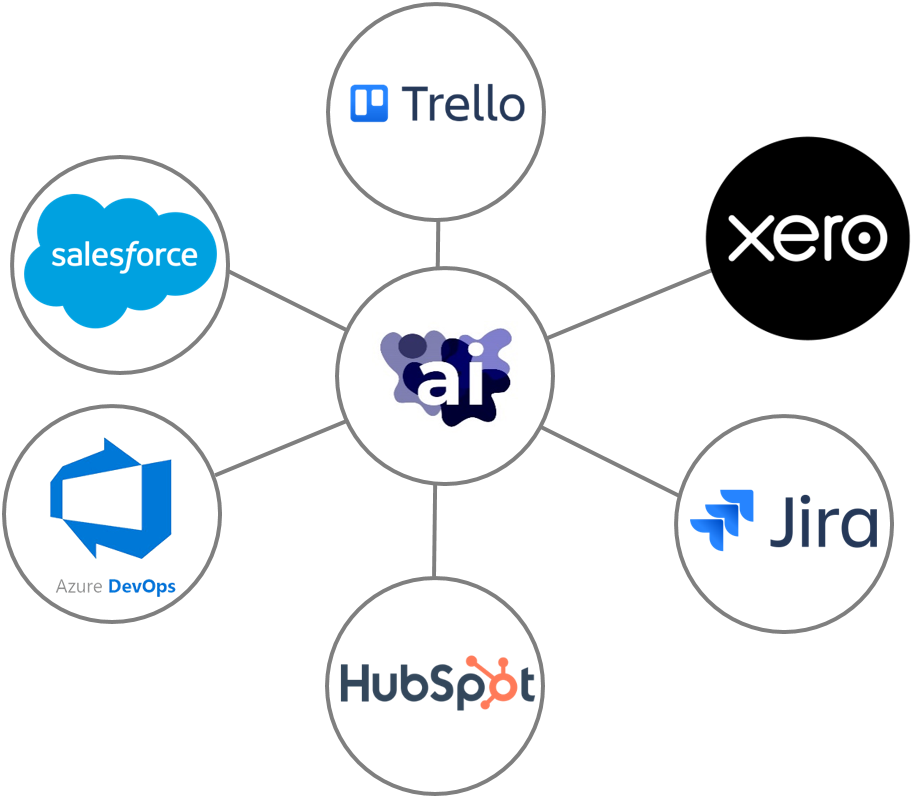 How to be a true mid-market leader
How to be a true mid-market leader
Benchmark yourself – know where you stand
The first step to making any changes to increase productivity is to fully measure and understand where you are now. With Strategy-AI, that’s with a Strategic Alignment Retrospective workshop. This is the same workshop I discussed above. The outputs of this will give you a benchmark to where you are now, and by repeating then as frequently as your business can (quarterly is the suggested frequency) you can keep track and monitor misaligned work, adjusting and adapting as required.
It runs exactly the same as I’ve described above, however instead of exporting all your project and task data as well as the key driving factors from your strategy to Excel, Strategy-AI brings those same key driving factors from your strategy directly into your project and task management platform.
From the project management tool you’re already using, open the 6-, 12- or 18-months’ worth of work-items (sub-projects, tasks and sub tasks) you want to review, check and mark them to your key drivers (just as above).
When you’ve reviewed the work-items, open anyone of the alignment reports to visually see your alignment. If you’re a business that uses agile you can use our Sprint Alignment reports. These show you how aligned your sprints have been over time. Each sprint measured and assigned an easily consumable Strategic Alignment Score. These scores can be adjusted and filtered based on a variety of criteria that suits your needs and used to benchmark how your business has been performing.
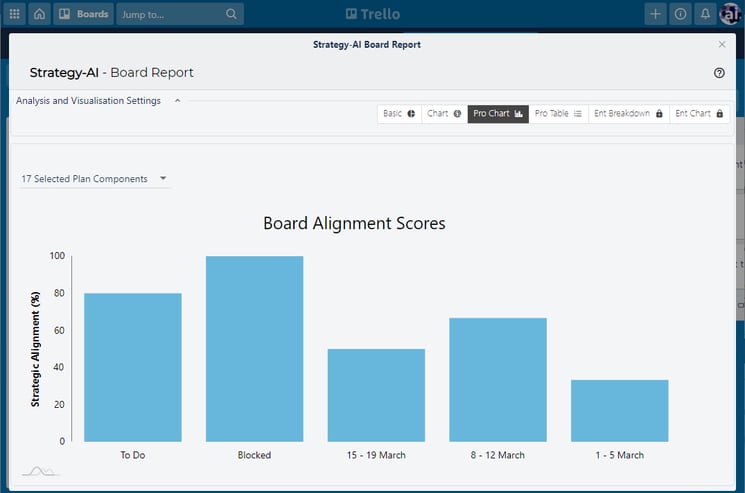
Make your strategy visible
As a leader, I'm sure you've heard the saying "don't put your strategy away in the drawer". And yet this is what many leaders will unknowingly do when they only following strategic projects. They’re only focusing on one aspect of the strategy and not the most important aspects... why they are doing these projects.
We've all heard that to overcome this, your strategy should be visible and easily accessible, and yet they're still not readily accessible when and where they're needed. Two years ago, when we were all in the office, having your strategy on the wall made some sense... even if you had to leave a meeting room to refer to it during a meeting, but in these remote working times, that's not working. PDF copies of your strategy, buried on the corporate network, in a OneDrive/Dropbox folder or in a wiki page, is neither visible nor accessible. As I mentioned above, making a strategy visible and available was a great way to get the whole business to live and breathe it.
With Strategy-AI, this can start by simple adding the key driving factors your business has into any one of our industry best practice templates that best suits your business. From here it’s as easy as turning on or off the plan’s visibility. This flexibility is perfect if you highly sensitive factors and require strict visibility rules or if your planning is more department based, so your business has more than one plan.
Your key driving factors are now readily visible to your staff reenforcing the relevance and importance of their work, bringing meaning to the actions and tasks they are acting on. Everyone can now derive a sense of value and satisfaction knowing how the work they are doing is actually contributing.
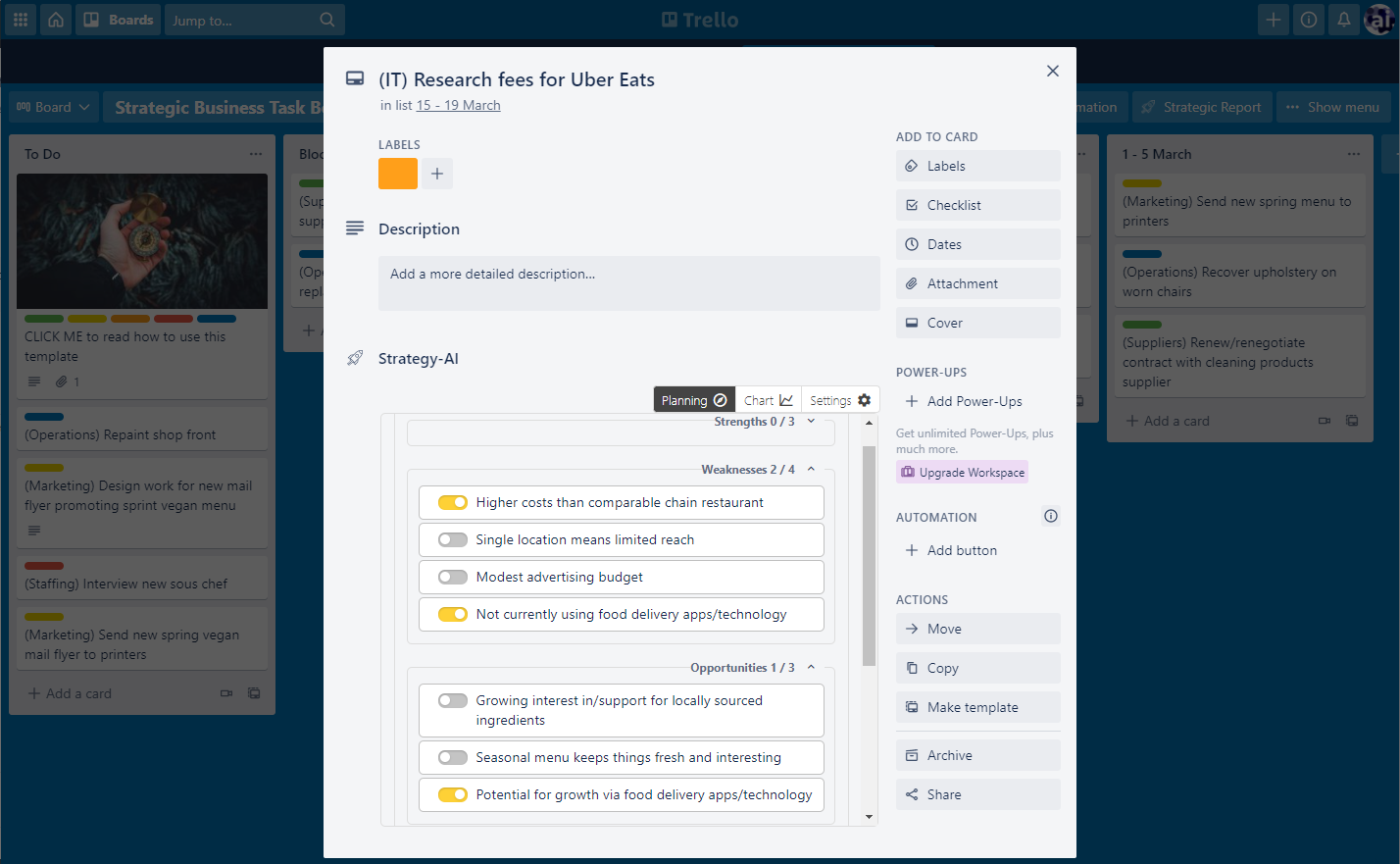
Catch misaligned work earlier than ever before, at a higher frequency
The final step to a fully, digitally led strategic workforce, is the one aspect the manual process couldn’t deliver, being able to catch misaligned work in between the quarter reviews. The aim here, being to catch work as early as possible, stopping any wasted expenditure.
This is done with the use of the Strategic Backlog/To-Do report… depending on whether your business is using agile or not. Simple open the report, select the business factors you are focusing on at the moment and see, in-real-time, the tasks and items that align and those that don’t in a prioritized, ordered list.
If the business changes the key driving business factors you have been focused on, just change your filter criteria, and immediately see the impact the change has had. You can even use this to inform the business of the impact a pending or possible change in focus will have on your department’s workloads.
It’s agile’s ordered and prioritized nature, but ordered and prioritized to the businesses key driving factors rather than priority based purely technical requirements.
Be the leader you crave to be
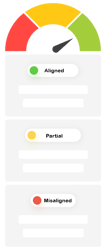
Improving your business is more than being a good leader, it's supporting your staff with the right tools.
Strategy-AI fully integrates with the major project and task management systems to bring your strategy front and center. Spot work that is strategically misaligned earlier, deprioritize work that isn’t aligned; avoiding the costs and expenses that aren't going to get you to success.
To get a first hand look at Strategy-AI, have a look at Strategic Task Management with Trello, or talk to us today about a demo or how Strategy-AI can help you reach success.

